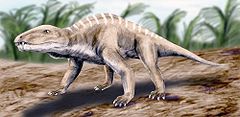- Dinocephalia
-
For other uses, see Dinocephalia (disambiguation).
Dinocephalia
Temporal range: 270–260 Ma Middle - Late Permian
Titanophoneus, a carnivorous dinocephalian of the Middle Permian Scientific classification 
Kingdom: Animalia Phylum: Chordata Class: Synapsida Order: Therapsida (unranked): Eutherapsida Suborder: †Dinocephalia
Seeley, 1895Groups see Taxonomy
Dinocephalia are a clade of large early therapsids that flourished during the Middle Permian, but became extinct leaving no descendants.
Contents
Description
Apart from the Biarmosuchia and the Eotitanosuchidae, the Dinocephalia are the least advanced among the therapsids, although still uniquely specialised in their own way. They retain a number of primitive characteristics (e.g. no secondary palate, small dentary) shared with their pelycosaur ancestors, although they are also more advanced in possessing therapsid adaptations like the expansion of the ilium and more erect limbs. They include carnivorous, herbivorous, and omnivorous forms, some semi-aquatic and some fully terrestrial, and were also among the largest animals of the Permian period; only the biggest Caseidae and Pareiasauridea rivalling or even exceeding them in size.
All dinocephalians are distinguished by having interlocking incisors allowing a shearing contact between upper and lower teeth. In more advanced forms, the heels on the lingual sides of the incisor teeth met to form a crushing surface when the jaws were shut, allowing the grinding up of plant matter.
Most dinocephalians also developed pachyostosis of the bones in the skull, which seems to have been an adaptation for intra-specific behaviour (head-butting), perhaps for territory or a mate. In some types, such as Estemmenosuchus and Styracocephalus there are also horn-like structures, which evolved independently in each case.
Dinocephalians are extraordinary for their large size. The biggest herbivores (Tapinocephalus) and omnivores (Titanosuchus), may have massed up to two tonnes in weight, and were some 4.5 meters long, while the largest carnivores (such as Titanophoneus and Anteosaurus) were at least as long, with heavy skulls 80 cm long, and overall weights of around half a tonne.
Evolutionary history
The dinocephalians evolved from a pelycosaur-like therapsid that lived in the late Cisuralian epoch. These animals radiated at the expense of the dying pelycosaurs, who dominated during the early part of the Permian. During the early Capitanian, advanced dinocephalia radiated into a large number of herbivorous forms; representing a diverse megafauna. This is well known from the Karoo. Shortly after, at the height of their diversity, the dinocephalians suddenly died out. The reason for their extinction is not clear. They were replaced by much smaller Therapsids: herbivorous Dicynodontia and carnivorous biarmosuchians, Gorgonopsians and Therocephalians.
Taxonomy
 Head of Stenocybus.
Head of Stenocybus.
Little recent research has been done into dinocephalian relationships. The following arrangement therefore should be taken as provisional only.
- CLASS SYNAPSIDA
- Order THERAPSIDA
- Suborder DINOCEPHALIA
- Mnemiosaurus
- ? Rhopalodon
- ? Family Phreatosuchidae
- Phreatosaurus
- Phreatosuchus
- Family Estemmenosuchidae
- Anoplosuchus
- Estemmenosuchus
- Molybdopygus
- ?Parabradysaurus
- Zopherosuchus
- Stenocybus
- Anteosauria
- Family Anteosauridae (=Brithopodidae?)
- Admetophoneus
- Anteosaurus
- Brithopus
- Chthomaloporus
- Doliosauriscus
- Family Deuterosauridae
- Family Syodontidae
- Family Anteosauridae (=Brithopodidae?)
- Tapinocephalia
- Family Tapinocephalidae
- Family Titanosuchidae
- Suborder DINOCEPHALIA
- Order THERAPSIDA
See also
References
External links
Basal therapsids Eutherapsida DinocephaliaEutheriodontiaMammaliaRelated categories Synapsids · TherapsidsCategories:- Dinocephalians
- CLASS SYNAPSIDA
Wikimedia Foundation. 2010.


